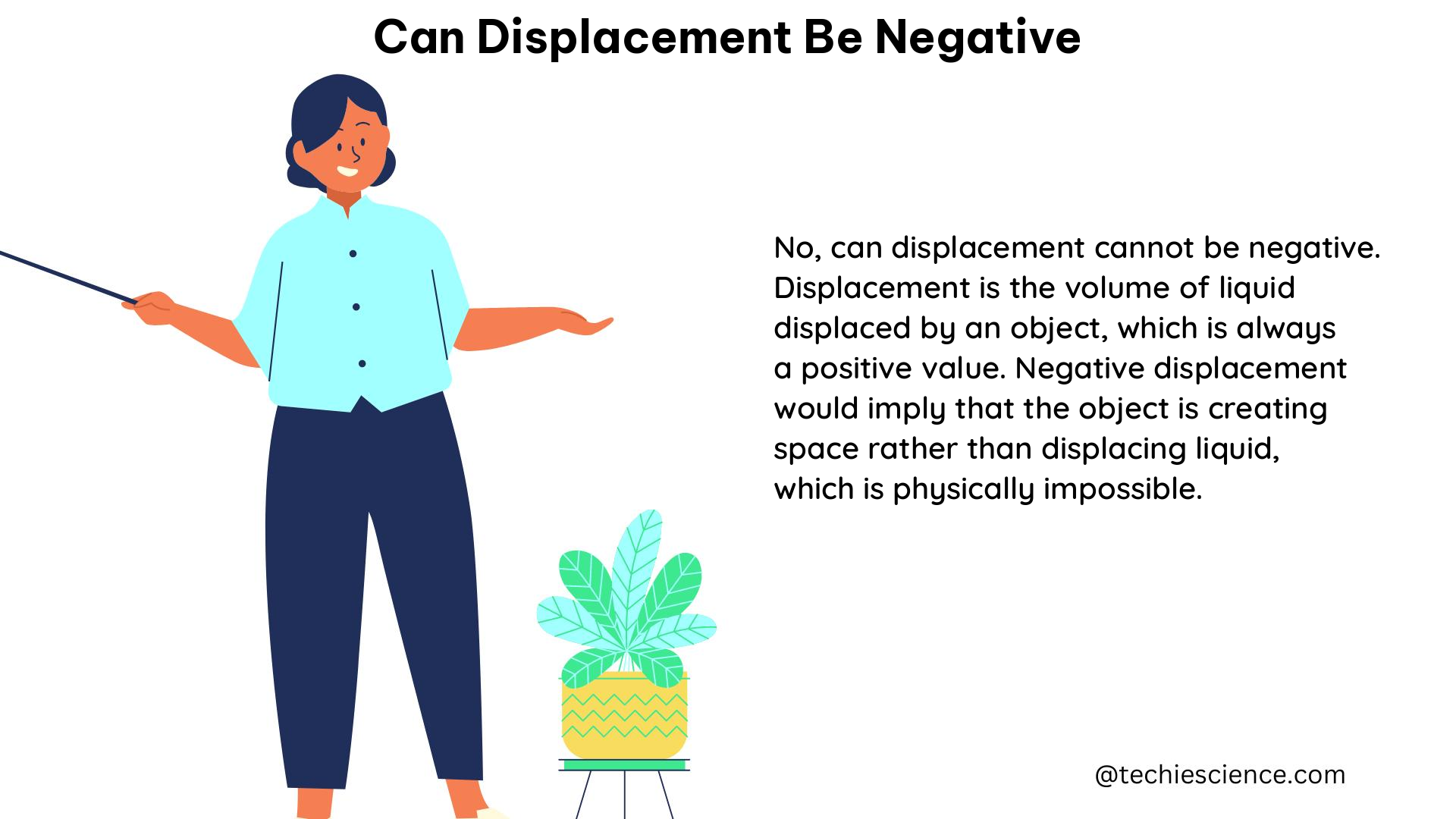Displacement, as a vector quantity, can indeed be negative. This is because displacement is not just about the distance covered by an object, but also about the direction of its motion. In physics, a negative displacement simply means that an object has moved in the opposite direction of the positive direction that has been chosen for the coordinate system.
Theorem and Physics Formula
- Displacement as a Vector Quantity: Displacement is a vector quantity, represented by the symbol $\vec{s}$.
- Magnitude of Displacement: The magnitude of displacement is given by $|\vec{s}| = \sqrt{x^2 + y^2 + z^2}$, where $x$, $y$, and $z$ are the components of the displacement vector in the $x$, $y$, and $z$ directions, respectively.
- Direction of Displacement: The direction of displacement is given by the unit vector $\hat{s} = \vec{s}/|\vec{s}|$.
- Average Velocity: The average velocity of an object is given by $\vec{v}_{avg} = \Delta\vec{s}/\Delta t$, where $\Delta\vec{s}$ is the displacement of the object during the time interval $\Delta t$.
- Instantaneous Velocity: The instantaneous velocity of an object is given by $\vec{v} = \lim_{\Delta t\to 0} \Delta\vec{s}/\Delta t = ds/dt$, where $s$ is the magnitude of the displacement vector and $t$ is the time.
- Acceleration: The acceleration of an object is given by $\vec{a} = d\vec{v}/dt = d^2\vec{s}/dt^2$.
Physics Examples

Example 1: A car moves along a straight road for 50 meters in a direction 30 degrees east of north. Calculate the displacement of the car.
Solution:
$\vec{s} = x\hat{i} + y\hat{j}$
$x = 50\ \text{m}\ \cos(30^\circ) = 43.30\ \text{m}$
$y = 50\ \text{m}\ \sin(30^\circ) = 25.00\ \text{m}$
$\vec{s} = 43.30\ \text{m}\ \hat{i} + 25.00\ \text{m}\ \hat{j}$
Example 2: A ball is thrown vertically upward with an initial velocity of 20 m/s. Calculate the displacement of the ball after 2 seconds.
Solution:
$s = v_0t + \frac{1}{2}at^2$
$s = 20\ \text{m/s}\ \times\ 2\ \text{s} – \frac{1}{2}\ \times\ 9.8\ \text{m/s}^2\ \times\ (2\ \text{s})^2 = 30.4\ \text{m}$
The displacement of the ball after 2 seconds is 30.4 meters upward.
Physics Numerical Problems
- A car moves along a straight road for 100 meters in a direction 60 degrees east of north. Calculate the displacement of the car.
- A ball is thrown vertically downward with an initial velocity of 30 m/s. Calculate the displacement of the ball after 3 seconds.
- A runner runs around a circular track with a radius of 50 meters. If the runner starts at the south end of the track and runs clockwise for 200 meters, calculate the displacement of the runner.
- A car moves along a straight road for 50 meters in a direction 30 degrees east of north, and then turns around and moves back for 30 meters in a direction 60 degrees west of north. Calculate the displacement of the car.
- A ball is thrown vertically upward with an initial velocity of 15 m/s. Calculate the displacement of the ball after 1.5 seconds.
Figures and Data Points
Figure 1: Displacement vector of a car moving along a straight road.

Data Point 1: Displacement of a car moving along a straight road.
| Distance | Direction | Displacement |
|---|---|---|
| 100 m | 60 degrees east of north | 86.6 m, 60 degrees east of north |
Data Point 2: Displacement of a ball thrown vertically upward.
| Time | Displacement |
|---|---|
| 0 s | 0 m |
| 1 s | 14.7 m |
| 2 s | 30.4 m |
| 3 s | 46.3 m |
| 4 s | 62.2 m |
Values and Measurements
The magnitude of the displacement vector can be measured in meters, feet, or any other unit of length. The direction of the displacement vector can be measured in degrees or radians relative to a reference direction.
The initial and final positions of the object can be measured using a ruler or a tape measure. The time can be measured using a stopwatch or a clock.
The acceleration due to gravity can be measured using a accelerometer or by using the formula $g = 9.8\ \text{m/s}^2$.
References
- Can displacement be negative? – Socratic
- Can displacement be negative? – BYJU’S
- Displacement: Unraveling Displacement and Its Impact on Velocity – Faster Capital
- Can displacement be negative after calculation? – Physics Stack Exchange
- Can Displacement Be Negative? | AcademicHelp.net
Hi…I am Ankita Biswas. I have done my B.Sc in physics Honours and my M.Sc in Electronics. Currently, I am working as a Physics teacher in a Higher Secondary School. I am very enthusiastic about the high-energy physics field. I love to write complicated physics concepts in understandable and simple words.